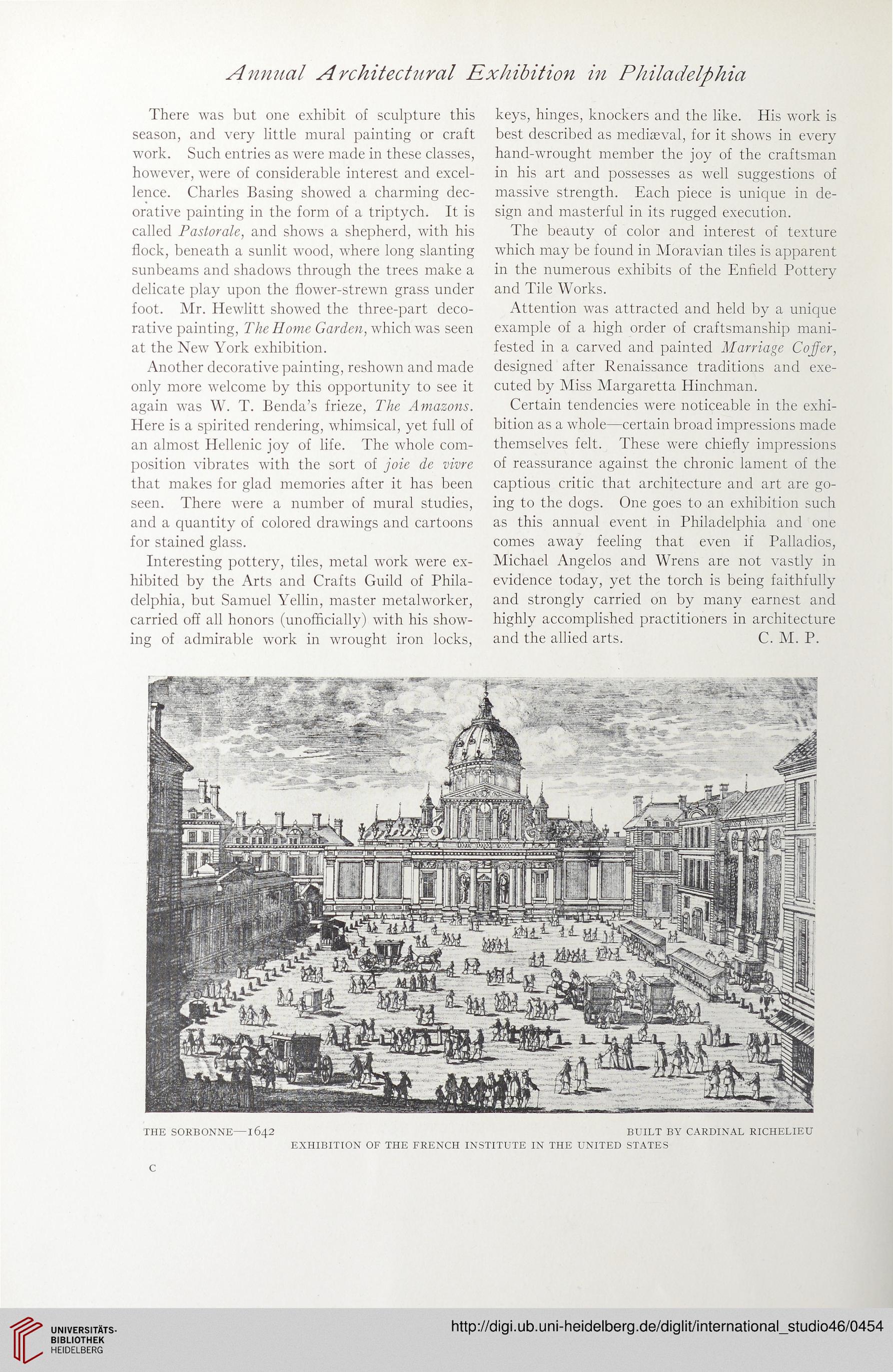Annual Architectural Exhibition in Philadelphia
There was but one exhibit of sculpture this
season, and very little mural painting or craft
work. Such entries as were made in these classes,
however, were of considerable interest and excel-
lence. Charles Basing showed a charming dec-
orative painting in the form of a triptych. It is
called Pastorale, and shows a shepherd, with his
flock, beneath a sunlit wood, where long slanting
sunbeams and shadows through the trees make a
delicate play upon the flower-strewn grass under
foot. Mr. Hewlitt showed the three-part deco-
rative painting, The Home Garden, which was seen
at the New York exhibition.
Another decorative painting, reshown and made
only more welcome by this opportunity to see it
again was W. T. Benda’s frieze, The Amazons.
Here is a spirited rendering, whimsical, yet full of
an almost Hellenic joy of life. The whole com-
position vibrates with the sort of joie de vivre
that makes for glad memories after it has been
seen. There were a number of mural studies,
and a quantity of colored drawings and cartoons
for stained glass.
Interesting pottery, tiles, metal work were ex-
hibited by the Arts and Crafts Guild of Phila-
delphia, but Samuel Yellin, master metalworker,
carried off all honors (unofficially) with his show-
ing of admirable work in wrought iron locks,
keys, hinges, knockers and the like. His work is
best described as mediaeval, for it shows in every
hand-wrought member the joy of the craftsman
in his art and possesses as well suggestions of
massive strength. Each piece is unique in de-
sign and masterful in its rugged execution.
The beauty of color and interest of texture
which may be found in Moravian tiles is apparent
in the numerous exhibits of the Enfield Pottery
and Tile Works.
Attention was attracted and held by a unique
example of a high order of craftsmanship mani-
fested in a carved and painted Marriage Coffer,
designed after Renaissance traditions and exe-
cuted by Miss Margaretta Hinchman.
Certain tendencies were noticeable in the exhi-
bition as a whole—certain broad impressions made
themselves felt. These were chiefly impressions
of reassurance against the chronic lament of the
captious critic that architecture and art are go-
ing to the dogs. One goes to an exhibition such
as this annual event in Philadelphia and one
comes away feeling that even if Palladios,
Michael Angelos and Wrens are not vastly in
evidence today, yet the torch is being faithfully
and strongly carried on by many earnest and
highly accomplished practitioners in architecture
and the allied arts. C. M. P.
THE SORBONNE—1642 BUILT BY CARDINAL RICHELIEU
EXHIBITION OF THE FRENCH INSTITUTE IN THE UNITED STATES
C
There was but one exhibit of sculpture this
season, and very little mural painting or craft
work. Such entries as were made in these classes,
however, were of considerable interest and excel-
lence. Charles Basing showed a charming dec-
orative painting in the form of a triptych. It is
called Pastorale, and shows a shepherd, with his
flock, beneath a sunlit wood, where long slanting
sunbeams and shadows through the trees make a
delicate play upon the flower-strewn grass under
foot. Mr. Hewlitt showed the three-part deco-
rative painting, The Home Garden, which was seen
at the New York exhibition.
Another decorative painting, reshown and made
only more welcome by this opportunity to see it
again was W. T. Benda’s frieze, The Amazons.
Here is a spirited rendering, whimsical, yet full of
an almost Hellenic joy of life. The whole com-
position vibrates with the sort of joie de vivre
that makes for glad memories after it has been
seen. There were a number of mural studies,
and a quantity of colored drawings and cartoons
for stained glass.
Interesting pottery, tiles, metal work were ex-
hibited by the Arts and Crafts Guild of Phila-
delphia, but Samuel Yellin, master metalworker,
carried off all honors (unofficially) with his show-
ing of admirable work in wrought iron locks,
keys, hinges, knockers and the like. His work is
best described as mediaeval, for it shows in every
hand-wrought member the joy of the craftsman
in his art and possesses as well suggestions of
massive strength. Each piece is unique in de-
sign and masterful in its rugged execution.
The beauty of color and interest of texture
which may be found in Moravian tiles is apparent
in the numerous exhibits of the Enfield Pottery
and Tile Works.
Attention was attracted and held by a unique
example of a high order of craftsmanship mani-
fested in a carved and painted Marriage Coffer,
designed after Renaissance traditions and exe-
cuted by Miss Margaretta Hinchman.
Certain tendencies were noticeable in the exhi-
bition as a whole—certain broad impressions made
themselves felt. These were chiefly impressions
of reassurance against the chronic lament of the
captious critic that architecture and art are go-
ing to the dogs. One goes to an exhibition such
as this annual event in Philadelphia and one
comes away feeling that even if Palladios,
Michael Angelos and Wrens are not vastly in
evidence today, yet the torch is being faithfully
and strongly carried on by many earnest and
highly accomplished practitioners in architecture
and the allied arts. C. M. P.
THE SORBONNE—1642 BUILT BY CARDINAL RICHELIEU
EXHIBITION OF THE FRENCH INSTITUTE IN THE UNITED STATES
C




